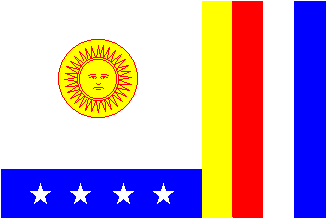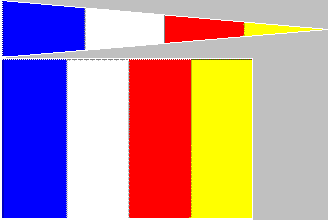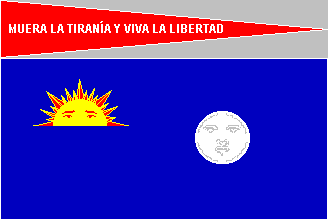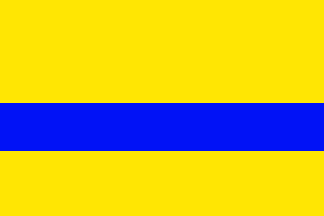
image by Guillermo Aveledo , 7 September 1999

Last modified: 2006-03-18 by dov gutterman
Keywords: venezuela | miranda |
Links: FOTW homepage |
search |
disclaimer and copyright |
write us |
mirrors
See:
See Also
Other sites:
I am referring, in particular, to six designs, ranging between
1797- 1811: The two flags of the Gual and Espana Conspiracy of
1797 (the cuatricolori design [of dubious mention and rare
depiction] and the sun-4 stars-cuatricolori design, which also
serves now as the flag of Vargas State); Francisco de Miranda's
Sun-and-moon flag (with banner) flown on the corbet
"Leander"; Miranda's first project for the Tricolori
(Black-Red-yellow) and the two designs used by the Vindicative
Junta for the Rights of Ferdinand the Seventh (the Junta which
rebelled against the Captain General Emparan's authority in 1810,
and which eventually proclaimed our independance from
French-invades Bourbon Spain), the two of them red-yellow-black
tricolori, one depicting the initials of King Ferdinand on the
yellow stripe, and the other depicting the effigy of the King on
the same spot.Also, I would like to mention the flags of the
Spanish Military Authority (under General Morillo) during the
Independence War, as well as the actual flag of the República de
la Gran Colombia (the federation of Venezuela, Nueva Granada
[Colombia] and Quito [Ecuador). I believe the information you
used for the Great Colombia is not correct. Its design is,
indeed, based in Miranda´s tricolori, adopted by the first
Vednezuelan Government of 1811 and it was certainly used by
Bolivar (with certain modifications) throughout his political
carreer. However, the symbolism cited by Fabio
Speciale is incomplete and the origin of the Miranda
Tricolori itself, mentioned by Mr Speciale is inaccurate. The
yellow, blue and red flag was not derived from Miranda's familya
colours. Despite the fact that he toyed with the idea of a South
Americna Kingdom, General Miranda was not a nobleman: he was not
the descendant of Spanish Officers or a member of the Criollo
nobility which ruled. While white, General Miranda was the son of
a well-off but not "honourable" craftsman. As a matter
of fact, a controversy with the local upper class over his
father's origins, led General Miranda to pursue a life abroad,
away from the discriminating province of Caracas. In such life,
he lived many adventures, joined the American and French
Revolutions, was part of Europe´s most important courts and,
while gazing at the colours of a Hamburg Granadier's regime, got
the idea for the tricolori (red-blue-yellow; depicted somehow in
every flag he designed). Also, there is no such thing a
Bolivar's Flag. Not what Mr Specially cites, at least. Bolivar
designed a flag much similar to that of 1814 , but adding one
blue star to the seven which lied already on the yellow stripe,
representing liberated Angostura.
Guillermo Aveledo , 22 September 1999
Francisco de Miranda, the Venezuelan revolutionary, designed
as many flags as he planned invasions to the New World in order
to overthrow the colonial regime. His tricolor, with all the
historic variants, is used to this day by Venezuela, Colombia and
Ecuador. Miranda was given full executive and legislative powers
in 1812 by the new Venezuelan Constitutional Government, and was
named Generalissimo, prior to the fall of the "first
Republic".
Guillermo Aveledo , 29 September 2000
it’s possible to affirm that SIMON BOLIVAR didn’t
create any Flag: nor for Venezuela, nor for the "War until
death" (historical period where the patriotic forces under
orders of El Libetrador gave not truce neither quarter to
royalist forces) nor for South America; much less for himself,
like also has been gotten to speculate. So, in our humble
opinion, the blue-yellow-red tricolor that you refers perhaps can
find its origin on a free interpretation - and even
something prejudiced - that bring to it FRANCISCO LABASTIDA, a
royalist witness, to the Flag hoisted by FRANCISCO OF MIRANDA on
the city of Coro, located in the Northwest of Venezuela - today
Capital of Falcòn State-, like part of his frustrated Liberator
Expedition on 1806. Our sources indicate that although
doesn’t exist an unquestionable testimony, the consolidated
tradition (at least on Venezuela) reaffirms that the order of the
horizontal and equal stripes of that flag was Yellow, Blue and
Red which is corroborated with 1811’ Flag, in whose creation
had also direct participation - even
preeminent- Miranda; however, in that opportunity the
Yellow stripe was wider than Blue and this one also was wider
than the Red one charging on the canton an emblem (non Coat of
Arms) whose main motive was an armed female Indian Chief sitting
on a rock and accompanied by a cayman, fruits and diverse
emblems. Because this emblem was embroidered you can imagine how
non-practical could be reproduce it on the middle of a war
conflagration like took place then in favor to our emancipation
and finally it was made without the emblem: this way was born the
National Flag of Venezuela which became Symbol of the Liberator
Army to consolidate as Flag of Great Colombia Federal Republic
between 1819 and 1830. Once dissolved that Union, between 1830
and 1836 Venezuela maintained the inequality of the stripes and
on 1836 it was equalized until our days incorporating on the
march her distinctive charges (Stars on the blue stripe and Coat
of Arms on the canton). As far concerns Colombia - and subject to
consultation and correction of ours Distinguished Colombian
Colleagues - between 1819 and 1834 was mantained the inequality
of the stripes; since 1834 to 1861 it was disposed vertically
with equal latitude and since 1861 asuumed its present
configuration of unequal horizontal tierced with yellow stripe
double-wider trhan the blue and red ones, characterizing it too
with the corresponding charges. With regards to Ecuador - and
here it’s applies the same consultation and correction
request to our not less Distinguished Ecuadorian Colleagues -
Tricolor of Liberator Army was hoisted on 1822 but it use was
consolidated since 1860 and officially adopted on November 1900,
distinguishing it with the respective charges.
So, although Bolivar qualified himself like "Potter of
Republics" seems very little probable that between their
remarkable attributes he counts to be, in addition, creator of
Flags. Here "between us" (in Venezuelan, in friendly
and close confidence) and under entirely personal opinion, I can
comment to all of you that before the overwhelming forcefulness
of the vexillographical speech created by Miranda, it was very
little what Bolivar could object and very much that he could take
advantage: therefore, he didn’t more that to reaffirm what
the facts had consolidated unquestionablily since 1811 into
Venezuelan feeling and carry our Tricolor by half-continent more
like a freedom emblem that as representative sign of
Latin-Americaness – still more, sincerely I difficult much
that Bolivar had the lightness to allow himself a pretension like
that if we remember his attempt to confederate on analogous way
that current O.A.S. our nations in the Isthmus of Panama on year
1828 -: and we reaffirm here the calification of "freedom
emblem" because the same merit, prerogative and treatment
also corresponds by right to “Albiceleste” Flag of
Argentina and the one of each People of Our Continent that then,
hoisting them, was taken up arms to reach his legitime
Sovereignity.
Because we want not to extend us too much, we can appreciate the
Vexilological "Aptitude"
and “Attitude" of Bolivar remembering which
he says in a letter wrote on 1826 from Paita to General Francisco
de Paula Santander in relation to the uncertainty (still
effective) that surrounds the origin of the colors of our Mother
Flag: "Also I have to confess sincerely, who although
I’m enjoy of general popularity, I don’t
knot how explain each one of the colors which compose our
Pavilion. This situation makes me hopeless until the last
point... ".
Raul Orta, 2 July 2005
1) 
image by Guillermo Aveledo , 7 September 1999
2) 
image by Guillermo Aveledo , 7 September 1999
These two desings are from the conspirative movement led
by Don Manuel Gual and Don Jose Maria España, the first of was a
retired captain of the militias batallion of Caracas, and the
seconds one a Major Justice of Macuto (a coastal town near
Caracas, in what is today Varga's State) in 1797. The two of them
set themselves , together with Spanish political prisoners sent
to Venezuela (like Juan Bautista Picornell or Manuel Cortes
Campomanes), to the task of overthrowing the Spanish domination
in Venezuela. They designed two flags (well, it is usually
attributed to both of them, even though there's certain
historiography which prompets us to belive that is was Manuel
Gual who did it), which were to go from town to town announcing
the good news of the Revolution which was to develop in Caracas.
Such attepmt was discovered, and all the conspirators were
executed promptly and the designs of the flags (some of which
were already made) were found within their documents.
Fortunately, those documents have survived until this date. The
first design, which is the better know one, consists of a large
white canton; over it , in the honour point, a yellow,
red-embroidered, sun inside a yellow circle, and a blue strip
beneath it with four white five-pointed stars. Over the fly end,
nex to the canton, we find the cuatricolori which seems to have
been their basic idea: four vertical stripes of yellow, red white
and blue. The sun, which simbolises "the fatherland and
equality, which is the law that must be observed by all",
did not have an specific number of rays coming out from it (nor
any number has bee attributed or set by local studies of the
flag); usually, it is depicted with 32 sunrays. The four withe
stars on the blue stripe (which is the sky and freedom)
represente the four provinces in which the revolution was to be
held: Caracas, Guayana, Cumana and Maracaibo. As for the
cuatricolori, in this design they represent the "intimate
union of the races under the cause" of the revolution. The
races referred to were: Pardos (or mestizos, white), Negros
(blue), Blancos (yellow) and Indios (red). No ratio is given
to this flag, so it has been assumes to be 2:3.The second design,
which is very rarely mentioned or depicted, is the representation
of a sketch which I found on the National Archives database. It
depicts a flag and a banner, both consisting of the cuatricolori,
but in a different order as the one in the previous design (blue,
white, red and yellow). The sketch suggested that the banner was
longer. As a matter of fact, it seemed that the longer banner
held yet a fifth colour, but this is not mentiones neither on the
sketch nor on the different books I've consulted. I will scan a
photo of it soon enough to let you see that. These two flags were
never raised, but both Gual and Espana are considered as
precursors of our emancipation movements, and the flags (one of
them exhibited at the Museo Bolivariano in Caracas) remain as a
sign of remembrance. Curiously enough, it was to their sons to
who was given the honour of raising for the first time the first
flag of Independent Venezuela in 1810.
Sources:
Erminy Arismendi, Santos (1954): Los Pabellones y Banderas de la
Patria. Tipografia la Nacion, Caracas.
Landaeta, Manuel (1903): Estudio sobre la Bandera. Caracas.
Vargas, Francisco Alejandro (1966): Los Simbolos Sagrados de la
Patria. Ediciones Centauro, Valencia.
VVAA (1998): Diccionario de Historia de Venezuela. Volumes 1 and
3. Fundacion Polar, Caracas.
Guillermo Aveledo , 7 September 1999
Project of Flag by Juan Bautista Picornell - 1797, Is
described in a letter supposed made by Juan Bautista Picornell:
one of the promoters of the conspiracy of Gual y España. Their
colors have a triple meaning: the ethnic groups Indian, Brown
(Creole), White and Black; the provinces of Caracas, Maracaibo,
Cumaná and Guayana and the revolutionary principles of Equality,
Freedom, Property and Security.
Project of Flag of Gual y España - 1797 - Probably derived of
the previous one, it was described in a letter of Manuel Gual
captured by the realists after frustrate the conspiracy which
leaded with Jose Maria España and Juan Picornell. The sun
symbolizes the Homeland and the Equality which like law must be
one for everyone; the stars represent the provinces of Caracas,
Cumaná, Guayana and Maracaibo, and the stripes allude to the
intimate union of the ethnic groups by the great cause of the
emancipation.
Raul Orta, 4 April 2002
1)
image by Guillermo Aveledo , 7 September 1999
Venezuela’s national flag was originally
created by the "Generalísimo" (Great General)
Francisco de Miranda. Miranda, who served in Europe in the years
of the French Revolution. He designed the Venezuelan flag,
inspired by a Hamburg regiment, whose colors were yellow, blue
and red. In 1806, Francisco de Miranda, on board the Leander
(a corvette) tried to invade Venezuela, and in March 12, 1806, he
disembarked near La Vela de Coro (western Venezuela) and hoisted
the yellow, blue & red flag. This flag has, on its corner, a
very peculiar "coat of arms": an indigenous woman,
holding a spear, sitting at dawn. Above her, the words
"Venezuela Libre" (Free Venezuela). At her feet, a band
reads "Colombia". We must remember that Miranda’s
ideal was to create a single country, from Mexico to Argentina,
naming it "Colombia" in honor of Christopher Columbus.
Jorge V. Alonso-Iglesias
The two designs herewith sent date from at least 1806, the
date of the invasion of General Francisco de Miranda (1750-1816)
to the shores of Coro, Venezuela. Early that year, Generla
MIranda set sail from New York on the ships (which he chartered)
"Leander", "Bachuus" and "Biee", in
an attempt to capture Coro and then conquering other Venezuelan
coastal cities. The invasion, as it was discovered by the Spanish
authorities and did not have support in the mainlad (Miranda was,
to say the least, a social outcast in the Venezuelan political
circles), failed deafeningly. Yet it helped him to breed support
from younger revolutionaries and conspirators (included the
future General Bolivar) who would look for him so as to find
leadership for the 1810 revolution. But that's another story
altogheter.The first design is known as the Leander naval ensign.
Even though it flew on the mast of the corbet
"Leander", and was never used since, the flag was not
necessarily considered an ensign. Yet its shape suggests so, and
so does the fact that he had a project for an military flag with
him on that invasion (however, the original flags were burned by
colonial authorities). The ensign was a "rectangular shaped
blue field with heavenly emblems": A dark-blue field
with the figures of a rising sun in yellow (the design suggests
that the sun is surging above the horizon) and a full moon in
white. The sun represented the dawning of a new era, and the full
moon was a symbol of elightenment, as it suggests light within
darkness. The blue field is both the sky and the sea (I have not
found any metaphorical use for this). To be hoisted above the
ensign we find a red banner which reads "Muerte a la Tirania
y Viva la Libertad" (Death to Tiranny, Long Live Freedom),
which of course explains itself pretty well. What is called
Miranda's tricolori (the yellow-blue-red flag used in Venezuela,
Colombia and Ecuador), is often mentioned as the flag hoisted by
Miranda on the "Leander". It has been proven, however,
that the design for the tricolori we know today was drafted
before this, and that the Leander naval ensign was not the
tricolori. Confusion arose form the memoir of an eyewitness of
Miranda's 1806 invasion: a certain Lieutenant James Biggs, an
American citizen, declared that he saw hoisted on board of the
"Leander", on the 12th of March, 1806, the
"colombian" flag: an ensign with the most predominant
colours of the spectre (yellow-blue-red). Biggs, however, did not
clearly described the flag, though he mentioned that it resembled
the heavens. Corny as Biggs might have been, he could have seen
the Leander Naval ensign, which is indeed a tricolori: yellow
sun, red banner and blue field. The tricolori as we know it
(three stripes), was inspired by the colours of an Hapsburg
Regiment of grenadiers.The second design is an alternative model
of Miranda's tricolori. Never made, it was a project he mentiones
to his followers and which he described in some of his essays. A
very simple flag, orginally designed as the "Vandera de
Miranda en su proyectado exexito con el nombre de
Columbiano" (Miranda's flag in his projected Army named
Columbian), it was formed by three equally high stripes,
horizontally-placed, of the colours black, red and yellow.
They represented the races of the Americas (and of his projected
parliamentary Kingdom of Colombeia): Negros (african; black),
Pardos (mestizos; red) and Indios (native indians; yellow). It
could have been designed in 1800, but there is no certainty about
that.
Guillermo Aveledo , 7 September 1999
Project of Flag by Francisco de Miranda - 1800. Exist in the
Document Catalogue of the General Archives of Indias in Seville,
Spain. By coincidence, is similar to the current Civil Flag of
German Federal Republic. Their colors represent the ethnic groups
Black, Brown (Creole) and Indian, respectively.
Primitive Flag of Venezuela - 1806. Conceived by Francisco de
Miranda, were affirmed on the Corvette "Leander" on
March 12th,1806 in Jacmel Bay, Haiti and hoisted later on
Venezuelan ground in August 3rd, that year. Although diverse
conjectures exist about it origin, the predominant hypothesis is
which Miranda took like model the primary colors from the
Arc-Iris. It presumed meaning is the golden territories of
America separated by the Sea-Ocean of the bloodthirsty Spanish
empire.
Raul Orta, 4 April 2002
Command Standard of Miranda, (1806): hoisted like emblem of
personal command on the Corvette Leander, it is a blue cloth
(possibly allusive to the sky and sea) where is emphasize a
golden rising sun to the lateral superior corner and a white full
moon in the floating inferior corner. Both charges appear
characterized with human characteristics, according to the
heraldic custom and use of the time. A red pennant with the war
voice "MUERA LA TRIRANÍA Y VIVA LA LIBERTAD" (Dead for
tyranny and long life for Liberty) complements this Standard that
represents the American Freedom raising itself in the horizon
(the sun) while the power of Spain (the moon) begins to decline.
Raul Orta, 15 May 2002
Flag hoisted by Miranda on the Church of Coro, 1806, as refers
by Mr. Antonio Navarrete, Spanish eyewitness of the time.
Raul Orta, 6 June 2002
Flag hoisted by Miranda on the Church of Coro, 1806, as refers
by Mr. Francisco Labastida, Spanish eyewitness of the time.
Raul Orta, 6 June 2002

image by Jarig Bakker, 25 June 2001
At "Evolution of VE flags" site at <www.lacasadelasbanderas.com>
you can see the "Bandera Tragica" of 8/1806. No more
info there.
Dov Gutterman, 25 June 2001
Tragic Flag of Miranda, 1806: is refers by Mr. Jaume Olle in
his site "Historical Flags" mentioning like source a
poster published by a flags manufacturer in Caracas, that as well
bases it on the illustrations of a mural located in a square of
the interior of Venezuela. In our modest opinion, it can be an
1811' later flag in which red declined more quickly than the
other two colors.
Raul Orta, 6 June 2002